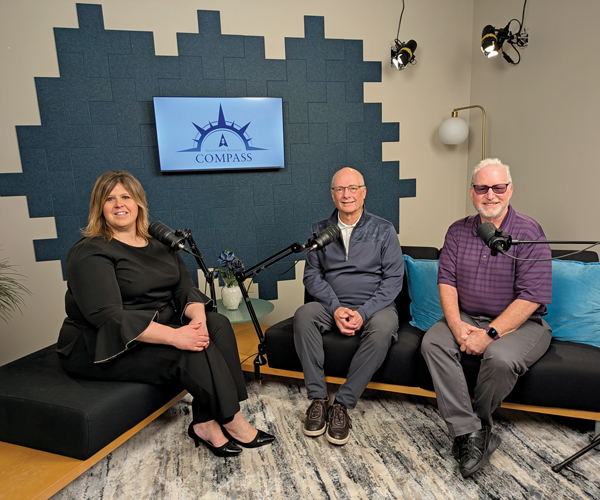The extensive windows on the front of the two-story building will provide lots of natural light and connect those inside to the busy cityscape outside. The panes of glass will also allow a neighborhood to see in and wonder about the intriguing, visible activities. The windows on the renovated building at East 63rd Street and Chester Avenue reflect more than just sun and shadows. They make the illusion of hope, success and jobs become real possibilities.
The 56,600-square-foot building will become the new home and high-tech innovation center for the Manufacturing Advocacy and Growth Network (MAGNET) upon projected completion in fall 2022. MAGNET purchased the vacant former Margaret Ireland School building from Cleveland Metropolitan School District in 2020. The redevelopment project comes with a $13 million price tag. The building will house MAGNET offices, classrooms, labs, entrepreneurial spaces and community gathering areas. A STEM-themed park, open to the public, will be created with help from Great Lakes Science Center.
“This building is not just a headquarters or a pretty face for a grandiose corporation,” insists Ethan Karp, MAGNET president and CEO. “Linking it to the MidTown innovation community seemed very appropriate. This is a physical place for the vision we have for manufacturing — getting more people interested in manufacturing careers, upgrading all of our companies so they use the latest and greatest technology and thinking about developing new products.”
Mark Olson is the lead architect on the MAGNET project and a principal with Bialosky Cleveland. He calls this building’s design process “an organic development, like kismet,” letting the building reveal its new purposes.
“MAGNET is a tremendous asset for Northeast Ohio,” says Olson. “You can’t keep farming out manufacturing jobs overseas. You need the capacity to produce things within our own borders. This will be a strong statement and a strong architectural building. You can see the past, present and future in modern architecture. Someone who went to the Margaret Ireland School will recognize it if they drive by, but they will also see much more.”
Margaret Allen Ireland, who was born in 1894 and died in 1961, was a social and welfare activist. She was a president of the Visiting Nurse Association and an early leader at the former county-run Highland View Hospital in Warrensville Heights. MAGNET also wants to “provide the neighborhood with an additional asset and to be a good neighbor,” according to Olson, who says the proposed playground and green space will be a part of that wish. Residents and community leaders of MidTown, Hough, Central and other Cleveland neighborhoods are optimistic about the MidTown innovation community.
“People have to visualize something before they say they can do it,” says Hough resident Carolyn Allen, a former city of Cleveland safety director who was a part of a group of folks who initiated new housing in the area in the 1990s. “Families can walk by the MAGNET building, look in the windows and parents can say to their children, ‘You can do that.’ People left this area because there were no opportunities for their children. MAGNET is essential to bringing people to this area and for preparing young people and older people for jobs.”
Mansfield Frazier is a 21-year Hough resident who praises the MidTown innovation community as “one of the best things that has come along in years.” A journalist and owner of the Vineyards and Winery at Chateau Hough, Frazier says, “Cleveland has basically been a city that has neglected the East Side for a long time, but that is starting to change.
“There is going to be some parity in this part of the near East Side,” he says. “It’s a great area for investment, and we are starting to see outside investors taking more of an interest, and we welcome it.”
The MAGNET building is a part of the center of the MidTown innovation community that Jeff Epstein, MidTown Cleveland executive director, is proud to see expand. In addition to MAGNET, other significant projects will star in the revitalization. Project master developer and Baltimore-based Wexford Science and Technology will transform tired areas into amazing game-changing locations. The Wexford complex, scheduled to open in 2023, will be a mix of retail, office and shared communal space.
“Wexford is the national leader in developing these kinds of complex innovation centers. It’s the only kind of development it does,” says Epstein.
The Cleveland Foundation is also moving its offices to a new building at the intersection of East 66th Street and Euclid Avenue, and completion is expected in 2022. After 40 years in Playhouse Square, the move to MidTown represents new opportunities for the foundation. Once again, it will become be a major part of a neighborhood’s revitalization while also becoming more accessible to recipients of its grants.
“We weren’t interested in going from one 13th floor to another 13th floor,” says Lillian Kuri, who was promoted to Cleveland Foundation’s newly created position of executive vice president and chief operating office March 1. “For the move, we considered next generation opportunities that weren’t just about our building.”
Kuri is proud that the 54,000-square-foot space will echo the foundation’s mission. That vision was translated by lead architect Pascale Sablan of S9 Architecture of New York. The award-winning Black and female architect hails from underrepresented groups in the profession, according to Kuri.
The building will be the second new mass timber construction in Cleveland. The framing style, which was once described as “huggable” and warm, makes use of large expanses of wood for floors, walls and other interior and exterior components, along with open, creative styling.
“The spirit is reflective of history, but kind of contemporary and extremely sustainable,” says Kuri, who holds a master’s degree of architecture in urban design from Harvard University.
The $22 million building will feature significant space devoted to community access and include a lobby, a community-led exhibition space featuring local stories through artwork, the Steven A. Minter Conference Center with free meeting space for nonprofits and a mostly grab-and-go public cafe offering multicultural food from Cleveland area restaurants and vendors. The cafe will be run by the HELP Foundation, which serves people with intellectual and developmental disabilities
In addition, Epstein points out that 500 residential units are in predevelopment in MidTown, neighborhood connector projects are being considered and the Dunham Tavern Museum campus will provide more accessible green space.
“MidTown has seen tremendous growth over the past 12 years,” says Epstein. “And in the core of where we are growing the innovation community, we have seen 1 million square feet of development since 2008 that is virtually full. These latest projects build on that momentum.”




